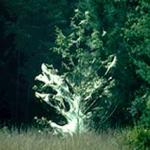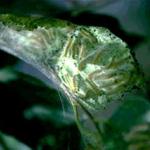Fall Webworm
Order: Lepidoptera
Family: Erebidae
Hyphantria cunea
Overview
The fall webworm is a widely distributed native pest that ranges from Canada to Mexico. It is native to North America, but is now considered a worldwide pest that is invasive to some locations. It has spread throughout much of Europe and Asia. For example, it was introduced (accidentally) into Hungary from North America in the 1940’s.
The fall webworm feeds on hundreds of deciduous plants. Hosts include nearly all shade, fruit, and ornamental trees except conifers. In the USA, at least 88 species of trees are hosts for this insect, while in Europe at least 230 species are impacted. At times, the fall webworm can cause extensive defoliation by eating leaves, stripping entire branches of its host plants. They can become a problem for ornamental trees in orchards, nurseries, and managed landscapes. In the US, they are a native insect that often is kept below damaging levels by abundant natural enemies, thus not requiring chemical management intervention. However, population increases are possible.
Host Plants
Dozens of different hardwood species act as hosts for this insect, some of the more common of which include: birch (Betula spp.), lilac (Syringa spp.), crabapple (Malus spp.), and cherry (Prunus spp.) in the Northeast.
Additional host plants include but are not limited to: alder (Alnus spp.), apple (Malus spp.), ash (Fraxinus spp.), black walnut (Juglans nigra), boxelder (Acer negundo), elm (Ulmus spp.), hickory (Carya spp.), hydrangea (Hydrangea spp.; Simisky and Whitehead Shell, personal observation), linden (Tilia spp.), maple (Acer spp.), mountain-ash (Sorbus spp.), mulberry (Morus spp.), oak (Quercus spp.), poplar (Populus spp.), stone fruit (Prunus spp.), sweetgum (Liquidambar spp.), sycamore (Platanus spp.), walnut (Juglans spp.), and willow (Salix spp.).
Identification/Life Cycle
In the history of the identification of the fall webworm, it was once thought that this insect was a two-species complex. It is now thought that H. cunea has two color morphs – one black headed and one red headed. Black headed caterpillars are yellowish-white in color and red headed caterpillars are brown in color. Both are covered in long, silky gray hairs. These two color forms differ not only in the coloration of the caterpillars and the adults, but also in their behaviors.
Females of the black headed morph lay eggs in a single layer mass during mid-March. Redheaded individuals lay eggs in double-layered masses in mid-April.
Caterpillars may go through at least 11 molts or instars, each stage occurring within a silken web they produce over the host. When alarmed, all caterpillars in the group will move in unison in jerking motions that may be a mechanism for self-defense. The growing degree day range for the activity of the larval life stage is estimated at 1266-1795, Base 50F, March 1st Start Date.
Depending upon the location and climate, 1-4 generations of fall webworm can occur per year. Due to cold winter temperatures, there may be 1-2 generations of fall webworm in Massachusetts annually. Fall webworm adult moths lay eggs on the underside of the leaves of host plants in the spring. Adults are approximately 3/4 inch in length with either all white wings or white wings with black spots.
Eggs hatch in late June or early July depending on climate. Young larvae feed together in groups on the undersides of leaves, first skeletonizing the leaf and then enveloping other leaves and eventually entire branches within their webs. Webs are typically found on the terminal ends of branches. All caterpillar activity occurs within this webbing, which becomes filled with leaf fragments, cast skins, and frass. Injury to the host plant is mostly aesthetic.
Fully grown larvae are approximately an inch long and then wander from the webs and pupate in protected areas such as the leaf litter where they will remain for the winter. Adult fall webworm moths emerge the following spring/early summer to start the cycle over again.
Damage
Small trees may be completely covered with silk and totally defoliated. However, injury typically happens late in the growing season, and if the tree is not under additional stress, the overall health of the host plant is often not impacted.
Foliage of many deciduous trees and shrubs may be fed upon and coated in webbing. Fall webworms typically do not cause extensive damage to their hosts. Nests may be an aesthetic issue for some, as they can be large, usually found at the branch ends encircling twigs, shoots, and containing shredded leaves. Typically, this insect is mostly a visual concern in the native part of its range in the US, and does not require chemical management.
Management Strategies:
Monitor for the silken webs created by fall webworm caterpillars on the branch tips which can be pruned out before they become extensively large. Webbing may first be seen on the south side of tree crowns. Webs become most obvious near the end of larval feeding and can persist for months afterwards. Larvae may have been feeding 3 to 4 weeks prior to webs becoming obvious. Small webs begin to appear in mid-July in Massachusetts, but are often not noticed until the fall. Natural enemies of the fall webworm in the eastern United States are abundant and should be preserved. Chemical management options for fall webworm in Massachusetts are available, however rarely necessary.
Cultural/Mechanical Management:
Physical removal of fall webworm webs while the caterpillars are still small in size is a helpful mechanical management strategy, especially on smaller trees and shrubs where the webbing can be safely reached. These can be pruned out and destroyed.
Never set fire to fall webworm webs. Not only does this practice disregard fire safety, but it can cause more damage to the host plant than the caterpillars themselves.
Lastly, a cultural solution to managing fall webworm (if in North America) is to learn to live with these native insects. They are a natural part of our forest ecosystems, and hosts of many other organisms. They rarely cause tree or shrub mortality, although can create unsightly webbing and cause some defoliation that may reduce host plant vigor. Because this occurs late in the season, most host plants have already built up a reserve of carbohydrates for the winter, and can withstand fall webworm defoliation. Outbreak population years, where fall webworm is regionally abundant, may be an exception.
Biological Control/Natural Enemies:
Over fifty species of parasites and over thirty-six species of predators are known to attack fall webworm in North America. The egg parasite, Telenomus bifidus, is cited as one of the most effective at managing fall webworm populations. Two notable parasites of fall webworm caterpillars include Apanteles hyphantriae and Meteorus hyphantriae. Bacillus thuringiensis kurstaki, a soil dwelling bacterium, is effective at killing the younger larvae.
Chemical Management:
Many active ingredients are labeled for use against fall webworm in Massachusetts, including but not limited to: abamectin (NL), acephate (NL), bifenthrin (NL), Bacillus thuringiensis subsp. kurstaki (NL), carbaryl (L), Chromobacterium subtsugae (NL), cyantraniliprole (NL), cyfluthrin (NL), deltamethrin (L), emamectin benzoate (L), flonicamid + cyclaniliprole (N), gamma-cyhalothrin (L), horticultural oil (L) (eggs), indoxacarb (L), lambda-cyhalothrin (L), malathion (L), permethrin (L), pyrethrins+piperonyl butoxide (L), spinetoram + sulfoxaflor (N), spinosad (NL) and tebufenozide (NL). Contact a Massachusetts licensed pesticide applicator for assistance.
Read and follow all label instructions for safety and proper use. If this information contradicts language on the label, follow the most up-to-date instructions on the product label. Always confirm that the site you wish to treat and the pest you wish to manage are on the label before using any pesticide. Active ingredients labeled "L" indicate some products containing the active ingredient are labeled for landscape uses on trees or shrubs. Active ingredients labeled "N" indicate some products containing the active ingredient are labeled for use in nurseries. Always confirm allowable uses on product labels. This active ingredient list is based on what was registered for use in Massachusetts at the time of publication. This information changes rapidly and may not be up to date. If you are viewing this information from another state, check with your local Extension Service and State Pesticide Program for local uses and regulations.
See the Professional Insect & Mite Management Guide for Woody Plants for more information about fall webworm management on trees and shrubs.
References
PennState Extension: Fall Webworm
UGA Extension: Fall Webworm
US Forest Service: Fall Webworm





